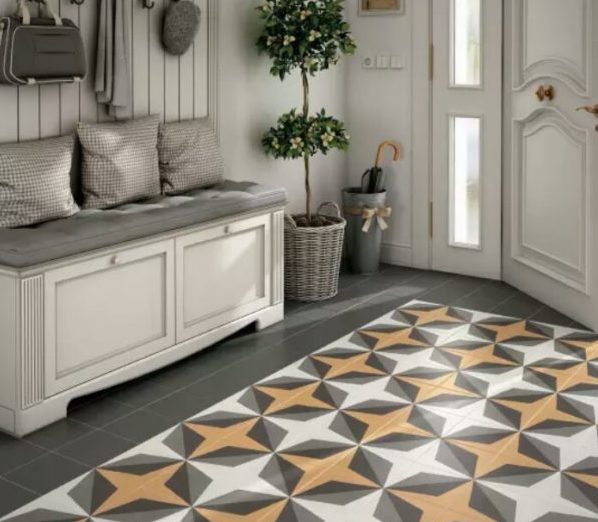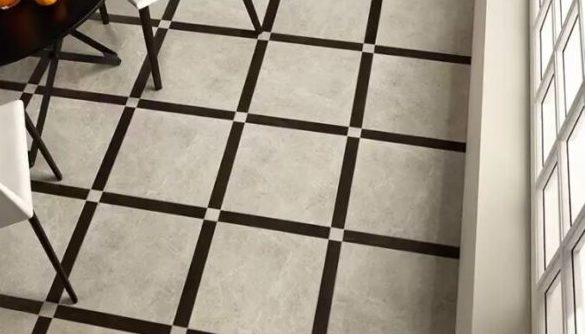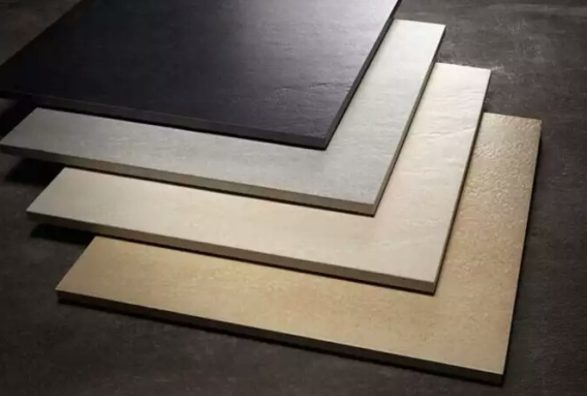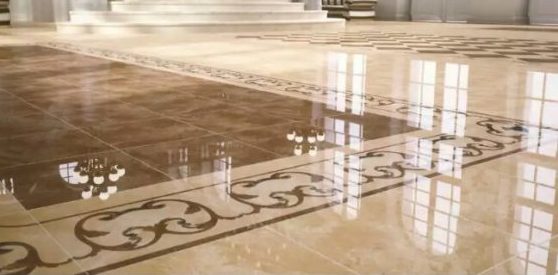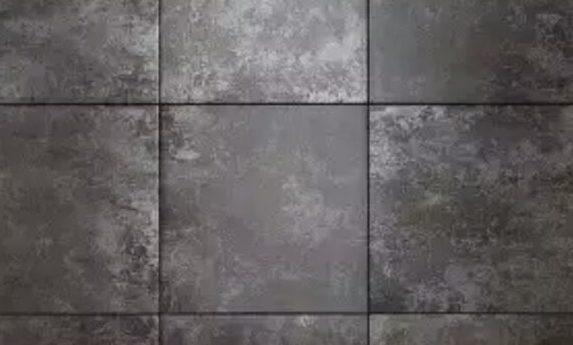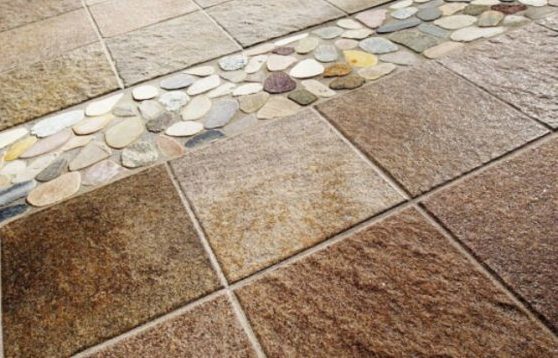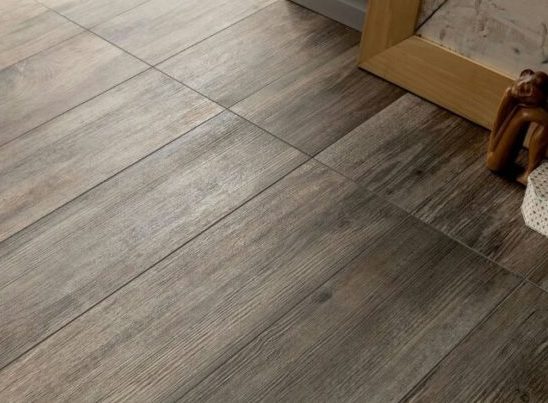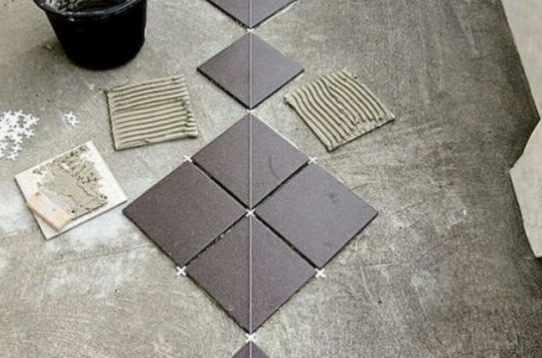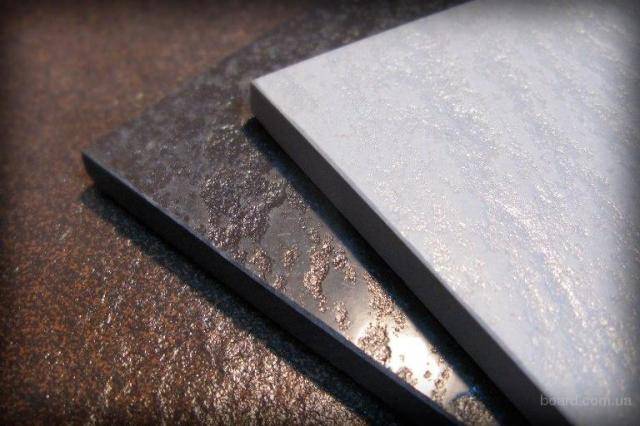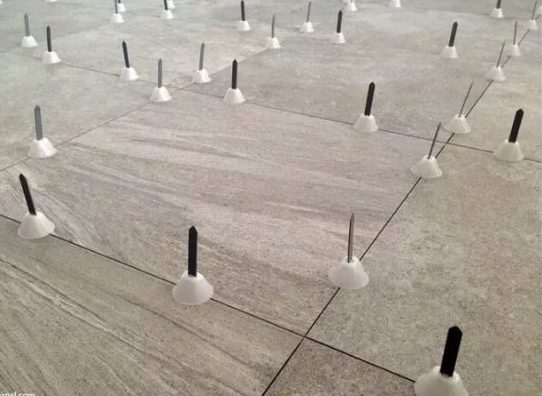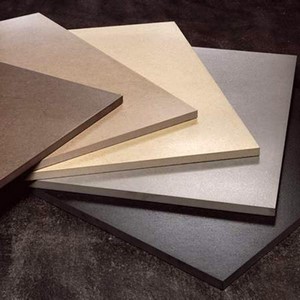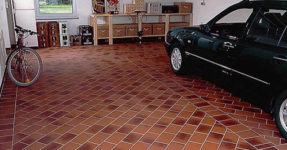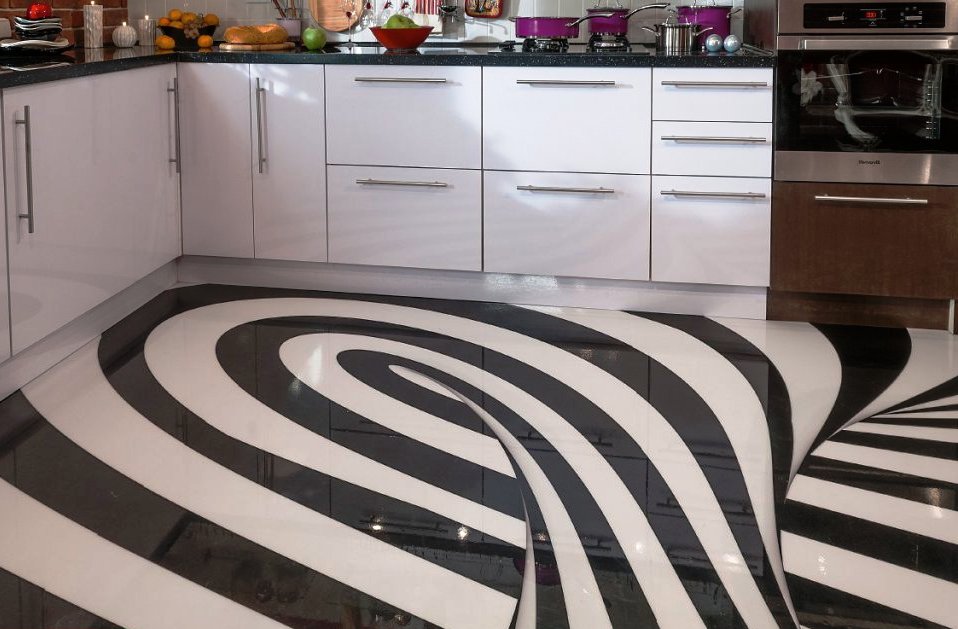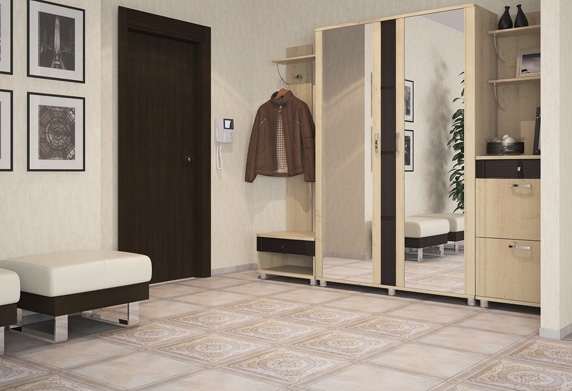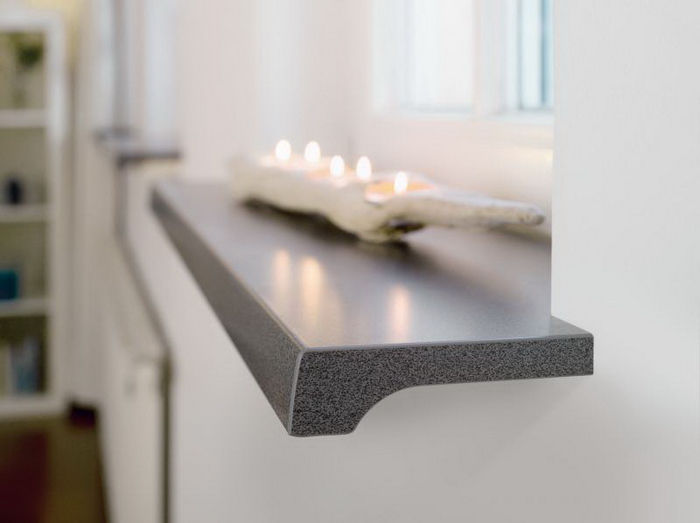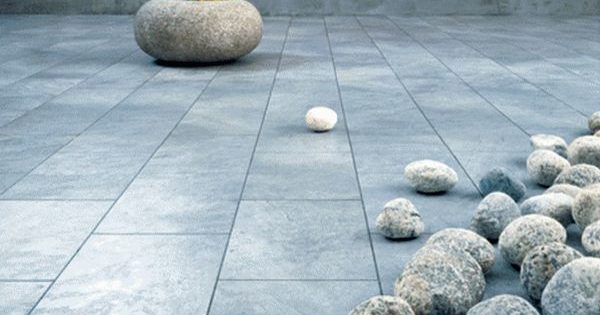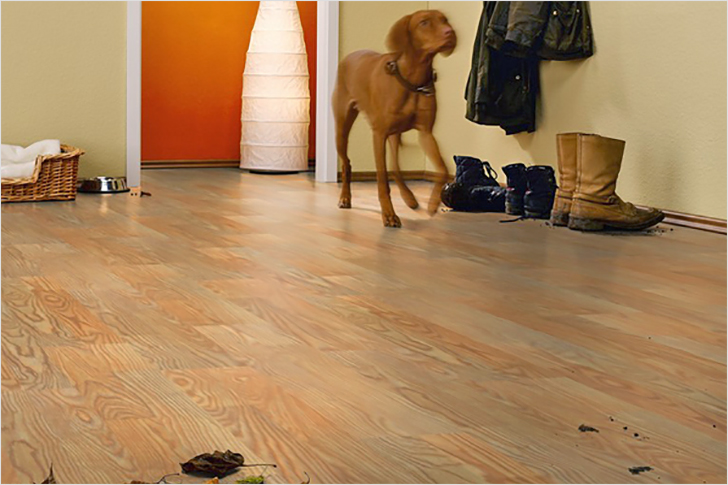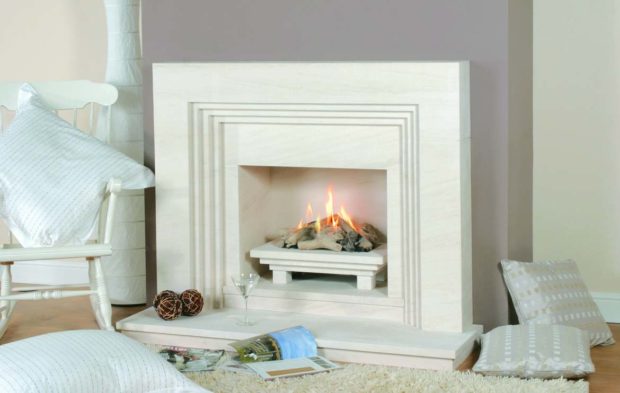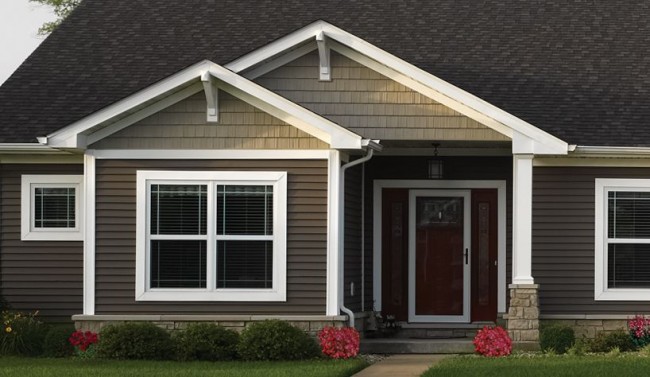9 tips for choosing porcelain tiles for the floor
Which porcelain tile to choose for flooring? Why porcelain tiles, and not ceramic tiles? Is there any difference between these types of coatings and what is the distinguishing feature of porcelain stoneware, we will consider in detail in this article.
No. 1. What is porcelain tile?
Porcelain tile is a very strong and durable type of facing coating, which can rightfully be considered a substitute for natural stone. The composition of porcelain stoneware includes such natural components as clay, mica, sand and feldspar, and a special additive in the form of granite chips gives this material special strength.
Porcelain is obtained by pressing and sintering. All components are mixed together in the required proportions, pressed at a pressure of 400-500 kg / cm², after which they are subjected to high-temperature annealing in an oven (1200-1300 ° С). Using this technology, it was possible to achieve the absence of pores in the finished material and its high strength.
At first, porcelain stoneware was used as a floor finish in industrial premises, with high loads, now technologies have stepped far forward, which made it possible to use porcelain stoneware not only as flooring in residential premises, but also for wall decoration and facades. We will consider in more detail those types of porcelain stoneware that are used precisely as flooring.
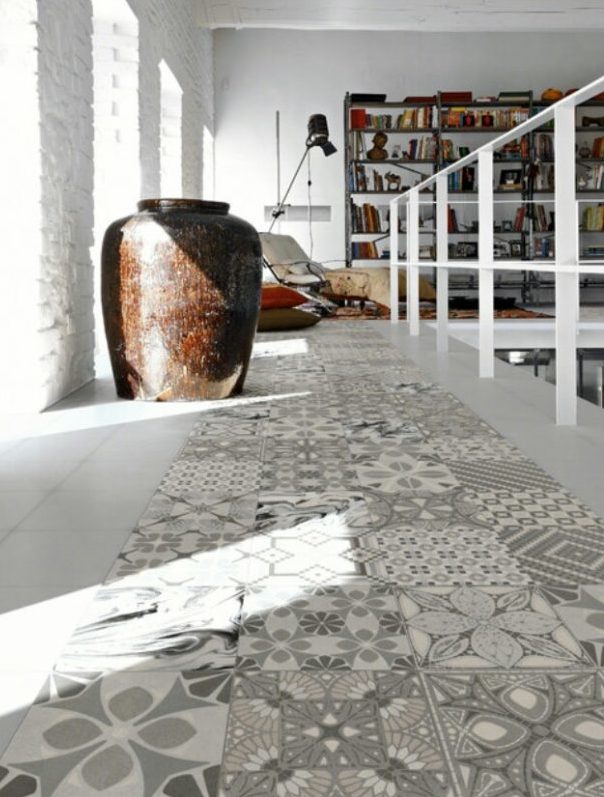
No. 2. Benefits of Porcelain Tile
The main Advantages of porcelain stoneware:
- Environmental friendliness thanks to the use of natural ingredients.
- Low coefficient of water absorption. Due to the almost complete absence of pores, porcelain stoneware does not absorb water, which makes it frost-resistant. Also, the absence of pores allows you not to be afraid that the adhesive mixture appears on the surface of the tile and spoils it, as is sometimes the case with tiled.
- Chemical resistance, be it an alkali or other acid, which makes it possible to clean it by absolutely any means.

- Wear resistance and high bending strength. Porcelain tile is so durable that it has a very high bending strength per m², which makes it possible to lay it even on an uneven surface.
- Resistance to mechanical stress. The glossy surface of porcelain stoneware does not lose its luster and is scratch resistant for many years.
- Color consistency. Porcelain tile is absolutely not affected by ultraviolet radiation, which allows it to maintain the clarity of the pattern and color brightness even with prolonged exposure to the sun.

- Anti-slip coating. There is a matte, slightly rough version of porcelain stoneware that will remain non-slip even when wet.
- Thermal conductivity. This material does not allow cold and will retain heat well.
No. 3. Types of Porcelain Tile
The following types of porcelain stoneware are most suited as flooring:
- Technical porcelain tile. Ideal for flooring in the production room.

- Matt porcelain tile. This type of porcelain tile does not lend itself to any additional changes after going through a heat treatment cycle. This makes its surface a little rough and discreet.But it has increased hardness and anti-slip properties.

- Polished porcelain tile. A more capricious appearance than the previous one has a smooth, even surface, almost mirror-like, thanks to processing with abrasive substances. This treatment somewhat reduces its wear resistance. For a longer service life, it must be treated with special mastics that create an additional protective layer on its surface. Otherwise, during prolonged use, polished porcelain tiles smoothly turn into matte.

- Satin. This porcelain tile has an unobtrusive light shine, which is obtained by applying mineral salts to the surface before baking in the oven. This type of treatment does not affect the indicators of wear resistance.

- Structured the type of porcelain stoneware has a relief surface, it allows you to simulate the texture of wood (parquet stoneware), leather or various types of stone. Visually and to the touch practically does not differ from natural materials.

- Glazed porcelain is obtained by applying special glaze to the surface and subsequent firing. The glazed surface is much stronger than ordinary ceramic tiles, however, this type of porcelain tile is not recommended for use in rooms with high traffic and a high level of mechanical stress. Over time, he loses his outward appeal.
- Lappated porcelain stoneware has a mixed texture - half polished, half matte. This effect is achieved by removing a thin, uneven top layer using special polishing stones. This kind can be safely used for flooring in rooms with high traffic and high load.

- Double backfill.The top layer of the tile, approximately 3 mm, is made of components of the required colors, and the bottom layer of the main components. Thus, bright, colored tiles are obtained, the wear resistance of which is maintained at a high level.
Number 4. Porcelain classification
- The size. The most popular tile sizes for flooring are square tiles with dimensions of 300 × 300 mm, 450 × 450 mm and 600 × 600 mm. If you have in mind some kind of design and unusual project, and the floor will be the center your interior, then you also have at your disposal tiles of the smallest size - 50 × 50 mm, and non-standard sizes - 200 × 200 mm, 150 × 300 mm, 300 × 450 mm, 300 × 600 mm, 400 × 400 mm. If you still haven’t found the right size for you, you can get it using waterjet cutting.
- Caliber - this is the value of the permissible difference in the size of the tiles, component 3-5 mm. During the heat treatment, the edges of the tiles are slightly deformed, so they can differ from each other in order to avoid a large difference in size, the tiles go through the process rectification, that is, trimming the edges on special equipment. Such tiles of porcelain during subsequent installation will be coincide perfect.
- Thickness. The maximum thickness of porcelain stoneware is 30 mm, the minimum is 3 mm. At right styling flooring with a thickness of 3 mm, its strength and wear resistance is in no way inferior to a coating with a thickness of 30 mm, so it makes no sense to give preference to the thickest, and therefore more expensive porcelain stoneware. For instance, recommended it is for flooring tile thickness 8.5 mmwithstand a load of 200 kg / cm2.
Abrasion class. Abrasion (wear resistance) - home technical characteristic porcelain stoneware. Depending on the degree of stress and mechanical stress, they are distinguished 5 major grades abrasion resistance:
- PEI I, PEI II - for rooms with low passability in soft shoes (bathroom, restroom);
- PEI III - for premises with an average level of passability, without access from the street or from the yard (balcony, kitchen, hallway);
- PEI IV - for public areas with a high level of patency;
- PEI V - for rooms with any level of patency and mechanical impact.
For example, for flooring in the whole apartment, class III abrasion is quite enough, and for bath and toilet, I or II class can also be used. If your task is to choose porcelain tiles for a private house, then in the corridor choose IV class, and for porch give preference to the V class, which, moreover, is frost-resistant. In the remaining rooms, III class will also be sufficient.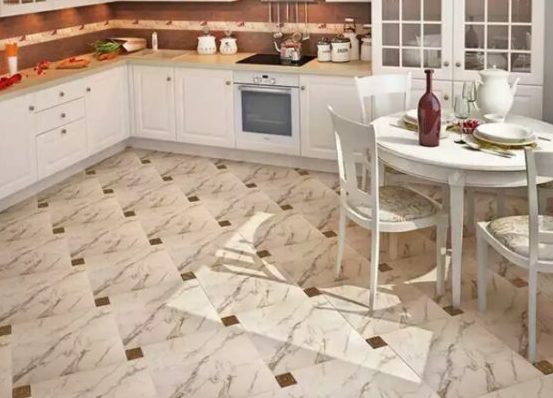
No. 5. Is porcelain tile and tile the same?
Many people mistakenly believe that this is really the same type of flooring, they just decided to reduce the name and raise the cost ... But this is far from the case. Differences really have what significant:
- Porcelain undergoes heat treatment at a significantly higher temperaturesthan tile, which explains it higher strength and wear resistance.
- Due to high temperatures, the components of porcelain tiles literally melt during processing, which is completely eliminates the appearance of micropores. This prevents moisture from entering the internal structure, therefore porcelain stoneware is able to withstand high subzero temperatures and do not crack at the same time. The tile has a porous structure and does not withstand large temperature differences.
- Porcelain stoneware is easy to clean - due to the absence of micropores, the surface is less polluted. Enough wet cleaning to maintain its beautiful appearance.
- Porcelain stoneware absolutely steady to any chemicals. This facilitates the cleaning process. Tile does not tolerate aggressive substances and can lose its luster from exposure to it, for example, alkalis.
- On the surface of porcelain stoneware, even after a long time, cracks and chips do not form. Despite the fact that on the tile you can observe microcracks on the surface after a couple of years of operation.
- Porcelain tile, due stamina to the impact ultraviolet light, even after 50 years, it will not lose its color and clarity of the picture, which can not be said about tiles, which eventually fade.
- On the surface of porcelain stoneware practically no stains. Have you noticed that when laying tile, the adhesive mixture sometimes comes to the surface and has to be changed, since this is an irreversible process? With porcelain, this will never happen thanks to his monolithic structure. Even if a coloring substance is poured onto the surface of porcelain stoneware, it can easily be removed without a trace.
- Porcelain tile has a large indicator bending strength, which allows you to lay it not even on an uneven surface. The tile breaks at the slightest distortion.
- The best porcelain tiles have absolutely smooth and clear edgesthat allows you to perform seamless styling.

No. 6. Application area
Due to the variety of colors and textures and their constancy, resistance to mechanical damage and chemicals, frost and bending, porcelain stoneware is used for wall and floor cladding as inside premises so and outside. Due to its high rates of hardness and abrasion, it is an ideal type of coating for industrial and public buildings. It is also used for decorating halls, swimming pools, floors in cafes and even at train stations. After all, this material is really eternal, and the possibility of producing various sizes makes it practically universal. Whatever room comes to your mind, you can always pick up the necessary type of porcelain tile. Porcelain replaced even parquet! And visually and to the touch does not differ at all from a natural tree. 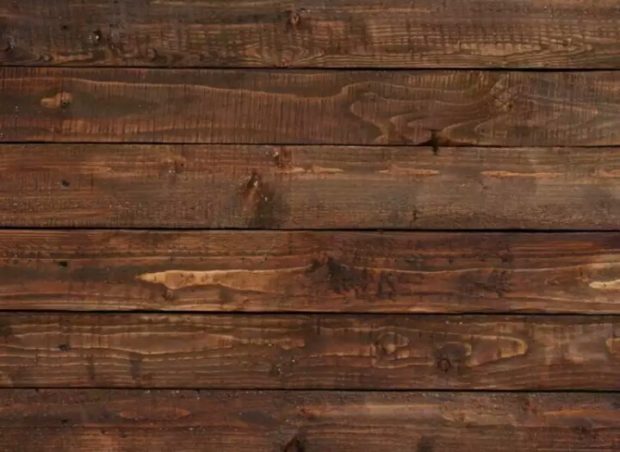
Number 7. Disadvantages of Porcelain Tile
Despite a number of significant advantages, as with any material, limitations porcelain stoneware also has:
- Porcelain Tiles able to prevent the passage of cold and retain heat, but, by itself, this material cold, in fact, like tile. Exit - Use underfloor heating.
- All types of porcelain stoneware, except for technical, matte and structured ones, when wet, will slippery.
- Of course, it’s worth noting high cost porcelain stoneware compared to tile. But in this case can argue, because it’s better to spend money once and get coverage with a guarantee of 50 years or morethan constantly changing cracked or burnt tiles. Moreover, now there are a lot of types of porcelain tiles from different manufacturers with different pricing policies. The highest price for Italian porcelain tiles, but there is also Belarusian, Turkish, Greek and Baltic, which allows you to choose the material with the best price-quality ratio.

Number 8. What should I look for when buying?
- Before buying, you must already know which the size Do you want to tiles. So you can easily navigate their quantityby dividing the desired coverage area by the area of one tile.
- Please note that all tiles match color and shade. All tiles must be from the same batch, otherwise the difference in color will be very noticeable after installation!
- Caliber all tiles should also be the same - This will ensure a beautiful, even styling without any visible differences in size.
- Required check weight! Recommended tiles for flooring, 8-8.5 mm thick, have a weight of at least 18.5 kg. Feel free to clarify this point, otherwise you risk buying a fake!
- back side tiles can also say a lot. It should have shallow, small squares with sides maximum 2 × 2 cm. The larger and deeper these technical notches will be, the lower the quality of the material.
- Do not forget about stock, which should be 10% of the total number of tiles with a diagonal laying method and 5% with other methods.
- On the packaging of porcelain tiles for flooring will be shown black footIf this sign is repeated, it means a higher class of wear resistance. If you will see snowflake - it is frost-resistant porcelain tile.

No. 9. Features of laying granite
If you decide to refuse the expensive services of professionals, and decide perform styling porcelain tile independently, you should very carefully approach this issue, because the durability of the coating will depend on the correct installation.
Porcelain tile, as a very durable material, is very difficult to cut, so that you do not have difficulties and surprises in the laying process, prepare everything at once necessary instruments:
- You will definitely need tile cutter or Bulgarian
- Required building level
- Flat edge spatula - for applying an adhesive mixture and a spatula with a serrated edge - for removing excess solution
- Construction bucket or other convenient for work capacityfor adhesive kneading mixtures
- Drill and special construction mixer to facilitate the kneading process
- Capacity for water
- Rubber hammer
- Plastic crossesthat adjust the width of the seam are chosen to your taste

Since porcelain stoneware is very heavy, it is necessary to choose a mixture that will withstand heavy loads. Better to choose plastic adhesive mixture with high indicators of “tenacity”, in addition, it prevents tile lagging if your house has not yet fully settled down and “walks” with changes in temperature or draft foundation. When the adhesive mixture is selected, go to the next step.
Surface preparation
Although porcelain stoneware and provides for differences of up to 15 mm, the surface is better preliminary alignby filling concreteby doing waterproofingthen carefully primer. If porcelain stoneware is laid on a warm floor, the sequence will be as follows - waterproofing the premises, laying a warm floor, pouring concrete (screed), soil impregnation, laying granite. By the way styling on old wooden floors not allowed. After preparing the surface, you can proceed to the mixture. Stir the adhesive mixture according to the instructions on the packaging. If you are laying tiles for the first time, do not knead the whole mixture at once, suddenly you will have difficulties in the process, and the mixture retains its adhesive properties for not so long. It’s better to start with a small amount, literally a couple of tiles and try to lay them, thereby checking their capabilities.
Stoning knramogranita
The sequence of actions is as follows:
- Mark the place for the first tile
- Apply a small amount of the mixture to the base with a smooth spatula and evenly distribute
- With a comb spatula, “comb” a place under the future tile; remove excess mixture
- Lean the tile firmly on the marked area
- Tap with a rubber mallet and remove excess mortar around the tile
- Put the next tile taking into account the thickness of the plastic crosses
If you want, using a thicker layer of adhesive mixture, to compensate for surface irregularities, it is better to additionally apply glue and on the tile itself. "Comb" the mixture on the base and on the tile must be perpendicular to each other. If you are facing the porch, give your preference seamless method. If, nevertheless, it is not possible to replace wooden floors with a concrete screed, then a layer of moisture-proof plywood must be laid on top of the old flooring. The adhesive mixture in this case must be elastic.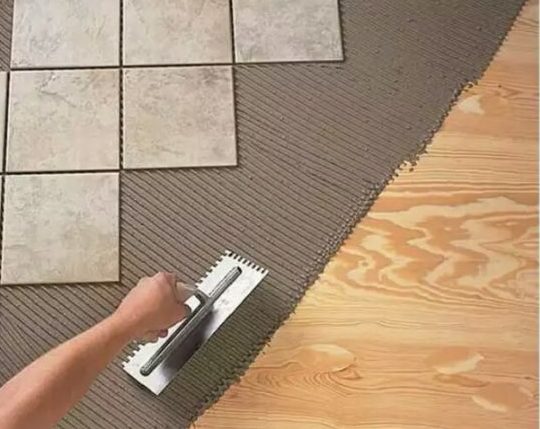
When laying porcelain tiles on the floor, you are unlikely to avoid the need to cut, for example, holes for pipes near heating radiators. It is also very rare that all tiles lie whole across the entire width or length of the room. A grinder or tile cutter will help you cut off the excess. And for curly cutting it is better to use jigsaw with diamond wire. Do not forget that trimmed tiles are better laid in the place where the furniture will stand and they will not be visible.
Good luck with your endeavors!

